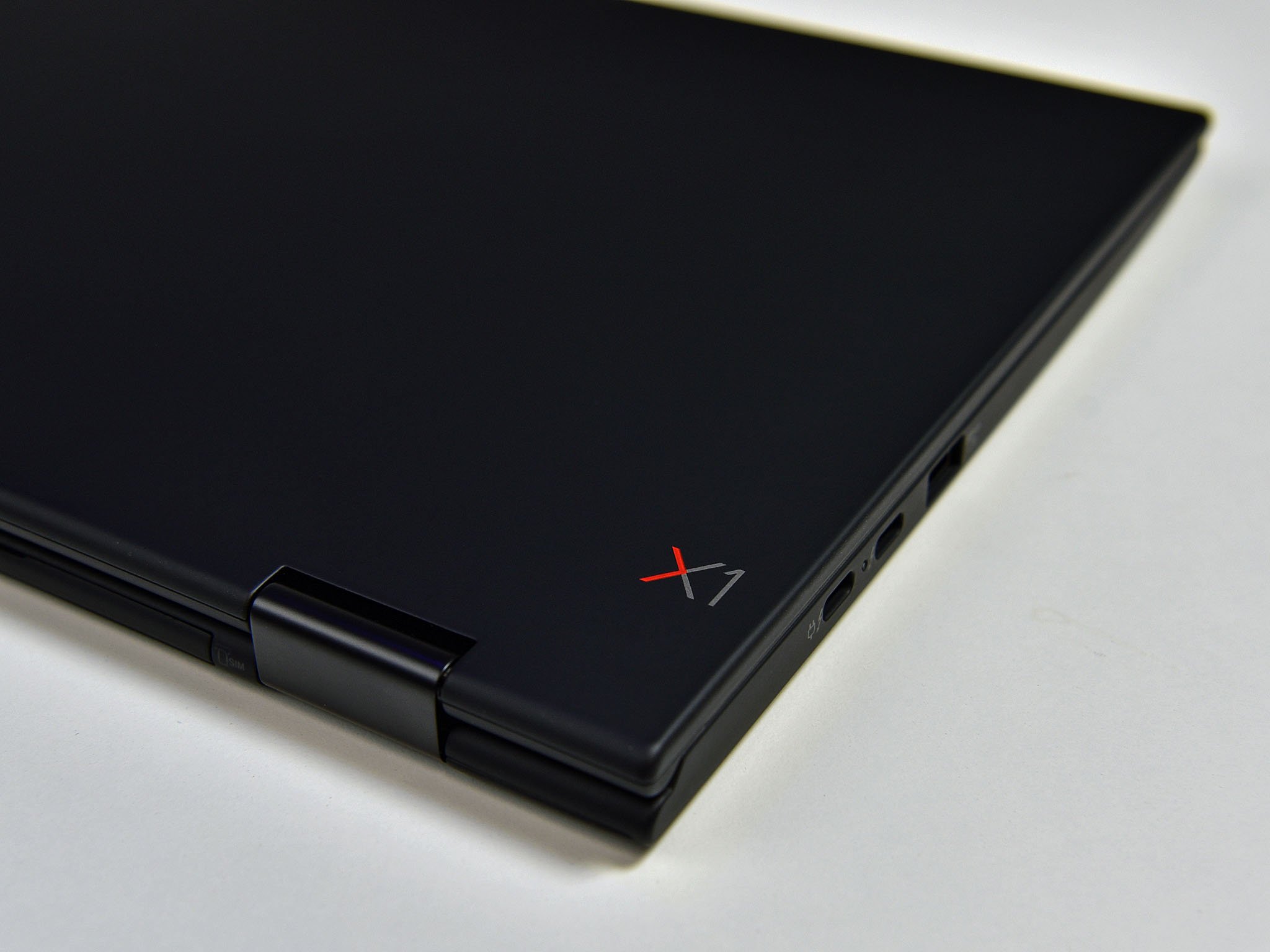Lenovo ThinkPad X1 Yoga 2018 nearly perfects the X1 Carbon as a convertible with a pen
This 2-in-1 business convertible is in every way an improvement over the X1 Carbon.


The Lenovo ThinkPad X1 Carbon (6th gen, 2018) is arguably the perfect traditional laptop – but what if you could make it better – and slightly more expensive? The Lenovo ThinkPad X1 Yoga (3rd gen, 2018) is that laptop, because it is a convertible that has a built-in pen. But there's are a few more tricks with the Yoga that make me prefer it over the capable Carbon.
I've spent the last few weeks with the X1 Yoga, and while the fingerprint reader is as terrible as the X1 Carbon's, it's a much better laptop in many other ways.
ThinkPad X1 Yoga 3rd gen what's new and features
The business-focused ThinkPad X1 Yoga is very much a sister device to the X1 Carbon but with a few signature moves like turning into a tablet with a 360-degree hinge. Because of that, the X1 Yoga follows the Carbon with new and improved features for 2018, including:
- New powerful and efficient 8th generation quad-core Intel processors.
- New HDR display with Dolby Vision and 100% AdobeRGB color gamut.
- New 360° far-field microphones for use with voice assistants and Alexa (coming soon).
The new processors include up to the highly-performance Core i7-8650U, which can clock at 4.2GHz for turbo – a very impressive choice for a convertible laptop.
And like the X1 Carbon, the X1 Yoga features a 14-inch display that ranges from full HD (1920 x 1080) up to WQHD (2560 x 1440). Seeing as there is native pen support for the Yoga (versus the Carbon) these are all multi-touch displays that have an anti-reflective coating. While not quite a matte display, they are less glossy than standard screens.
| Category | Lenovo X1 Yoga 3rd gen |
|---|---|
| Display | 14-inch 1920 x 1080 or 2560 x 1440 Multi-touch Anti-reflective, anti-smudge Dolby Vision HDR (optional) |
| Pen | Yes (built-in) Wacom AES (2,048 levels, no tilt) |
| Processor | Up to 8th Gen Intel Core i7 8650U with vPro |
| Graphics | Intel UHD 620 |
| RAM | 8GB or 16GB DDR3 2133MHZ |
| Storage | Up to 1TB PCIe-NVME SSD OPAL2.0 |
| Ports | 2 x USB 3.1 Gen 1 (one Always On) 2 x USB 3.1 Gen 2 Type-C / Intel Thunderbolt 3 (Power Delivery, DisplayPort, Data transfer) HDMI 4-in-1 MicroSD card reader Ethernet Extension Connector |
| Connectivity | Intel Dual-Band Wireless AC (2 x 2) 8265 + Bluetooth 4.2 |
| Audio | Dolby Audio Premium Dual speakers (bottom edge) Noise-cancelling dual-array mic |
| Battery | 54Wh, up to 15.4-hour battery life |
| Dimensions | 333 mm x 229 mm x 17.05 mm / 13.11" x 9.01" x 0.67" |
| Weight | 3.08 lbs (1.4 kg) |
| Colors | Black or silver |
| Pricing | Starts $1,480 |
| Availability | Now |
That premium display – the new Dolby Vision with HDR – is just $160 extra, but now is touch and pen-enabled and anti-reflective. Those were two criticisms of the X1 Carbon, which now makes sense considering the X1 Yoga's positioning as a 2-in-1 laptop. However, just like the X1 Carbon if you opt for the Dolby Vision HDR display, you give up the right to an infrared camera (IR) for Windows Hello facial recognition. You still get a fingerprint reader, but it's awful.
All the latest news, reviews, and guides for Windows and Xbox diehards.

Additionally, there is a built-in Wacom AES active stylus that pulls from the right-side of the X1 Yoga's bottom chassis. A 15-second charge will allow the pen to be used for up to 100 minutes. Users can also bring any Wacom AES pen to use with the X1 Yoga including the Bamboo Ink. That's good too because while the AES stylus is great for quick notes, highlighting a PDF, or signing a document anything more than few minutes will cause some hand fatigue due to the super thin design of the stylus, which lacks good ergonomics.
For configuration options, users get the same bevy of processor, RAM, and storage options as the X1 Carbon, which is excellent. That includes the newer Samsung PM981 SSD and up to 16GB of DDR3 RAM.
X1 Yoga – The good

Make no mistake the X1 Yoga is a bigger beast than the X1 Carbon. The Yoga's footprint is slightly larger, and the extra half-pound is noticeable when comparing the two. But on its own, it is hard to be too critical of the X1 Yoga's design or dimensions. The deep black, soft-touch paint with the more modern X1 and Lenovo labels are a nice touch too.
Audio is surprisingly much better than the X1 Carbon – something which I dinged it for in my review. With the Yoga, there is much more resonance, with a richer, more satisfying sound likely due to the including of Dolby Audio Premium.
The HDR display is also better because of the anti-glare coating and touch abilities – both of which are lacking on the X1 Carbon. Like the Carbon, that HDR display yields 100 percent sRGB and AdobeRGB color accuracy – a stunning achievement. With 500 nits of brightness the Dolby Vision HDR display looks like an OLED, but performs like an LCD.
Battery life is well below the fifteen hours that Lenovo claims but within eight hours on a busy day and can push towards ten for lighter processing. All of that is improved with the USB Type-C fast charge and 65W charge, which with a 30-minute charge will give you half a day's battery back.


Inking is also very good with the X1 Yoga, but don't confuse this laptop with a Microsoft Surface. The latter is geared towards more regular pen usage including artistic endeavors with things like tilt support. Compared this to the X1 Yoga, which is more business-focused the pen is aimed at signing documents, taking quick notes, and light sketching. That stylus is good too with the built-in Wacom AES controls, which results in lower pressure activation compared to what the Surface series uses.
Typing and trackpad (with Microsoft Precision drivers) are also excellent just like the Carbon. However, because the Yoga has a larger footprint due to the bezel around the display, the trackpad on the Yoga is also larger than the Carbon's. While the Carbon's trackpad isn't too small having a larger one on the Yoga is welcomed.


The ports are also like the Carbon giving a great mix and match of forward- and backward-looking options including USB Type-C, one of which is full Thunderbolt 3 (4x PCIe lane and 40Gbps).

For performance, the X1 Yoga is no slouch. Assuming you get it with the vPro-enabled Core i7-8560U the combined 16GB of RAM and ultra-fast Samsung PM981 SSD (with 3,000+ Mbps read and 2,000+ Mbps write speeds) the X1 Yoga is arguably one of the most performant convertibles on the market (at least until Dell's XPS 15 (9575) arrives this spring).
The X1 Yoga passes 12 MIL-STD 810G tests too like the X1 Carbon making quite resilient for those who travel a lot.
X1 Yoga – The bad

Like the X1 Carbon, the X1 Yoga has a terrible fingerprint reader. Sure, it works, and it keeps your fingerprint on the chip ("Match-in-sensor"), but you'll find yourself punching in a PIN on occasion as it fails to read.
A bad fingerprint reader is not a problem if you get the Windows Hello IR camera for facial recognition. However, to get that IR camera you must surrender the stunning Dolby Vision HDR display. Sure, the full HD version and the normal WQHD option are fine alternatives, but that HDR screen is drool-worthy. Tough choice.
The X1 Yoga also has some larger bezels around the display – totally understandable being a 2-in-1 convertible, but aesthetically it's less pleasing than the Carbon, which has thinner bezels.
There's also the usual complaints like the price – it can get very high if you opt for the 1TB of storage – and the black paint that picks up fingerprints all too easily (the silver body is much better than this regard), but we are now nitpicking.
It's also not clear when the option for 4G LTE-A will be available although Lenovo lists it as a product feature for the X1 Yoga.
ThinkPad X1 Yoga a jack of all

I gave the Lenovo X1 Carbon a 4.5 out of 5 rating only pointing out the high price, lackluster speakers, and mediocre fingerprint reader as cons. Still, aiming to be a traditional laptop, the combination of features, performance, and being so light and thin is a success for the Carbon.
If you liked the idea of the X1 Carbon but want touch and inking well, the X1 Yoga is your choice. The best part of the X1 Yoga is it feels like all the best of the Carbon with some bonus features. There's no trade-off here for performance, battery life, or even options – this is the X1 Carbon that can also now act as a tablet PC. That may seem trivial, but a few years ago the downsides with a 2-in-1 were often much greater.
Even if you use the X1 Yoga as a traditional laptop 95 percent of the time being able to convert it to tablet or pull out that stylus? Priceless. (Actually, it's about $100 difference between the Yoga and Carbon, but that's still reasonable).


As a tablet, the X1 Yoga is not light, but it's not bad either. That's due to the Lenovo Wave keyboard that pulls the keys into the X1 Yoga's chassis in tablet mode resulting in a flush back. For watching movies or presenting a video that presentation mode is excellent (audio is also better now since the speakers are top-firing).

You're also getting one of the best typing experiences around, a Precision touchpad, much-improved audio, and that dazzling HDR display.
Review: Lenovo ThinkPad X1 Carbon (2018)
I'd still prefer a 3:2 display aspect ratio but being a business laptop, I'm probably in the minority – for now. I'd also like to see Lenovo try to ditch the TrackPoint system (the red "dot" in the keyboard) as it results in a smaller trackpad and is starting to feel dated (sorry road warriors, it's time to move on).
Pros:
- Great 2-in-1 design and looks.
- The HDR display is now anti-reflective.
- Built-in active pen for whenever you need it.
- Pretty good audio!
Cons:
- Odd configuration options and limitations.
- Terrible fingerprint reader.
If I had to choose a model for myself, I'd get the Core i7-8650U processor, 16GB of RAM, that HDR display with the silver color scheme. Assuming Lenovo brings the 4G LTE-A option to market in May (like the Carbon) I'd wait for that too as it will greatly enhance this laptop's usefulness.
Choosing between this laptop and the X1 Carbon if you can spring the extra $100 get the X1 Yoga. While it is a half-pound heavier, it is better in many ways (and will be more future proofed).
In conclusion, Lenovo has a winner here. Putting aside a couple of grumbles this is a fun laptop that can also get work done for the pros.

Daniel Rubino is the Editor-in-chief of Windows Central. He is also the head reviewer, podcast co-host, and analyst. He has been covering Microsoft since 2007 when this site was called WMExperts (and later Windows Phone Central). His interests include Windows, laptops, next-gen computing, and wearable tech. He has reviewed laptops for over 10 years and is particularly fond of 2-in-1 convertibles, Arm64 processors, new form factors, and thin-and-light PCs. Before all this tech stuff, he worked on a Ph.D. in linguistics, performed polysomnographs in NYC, and was a motion-picture operator for 17 years.
